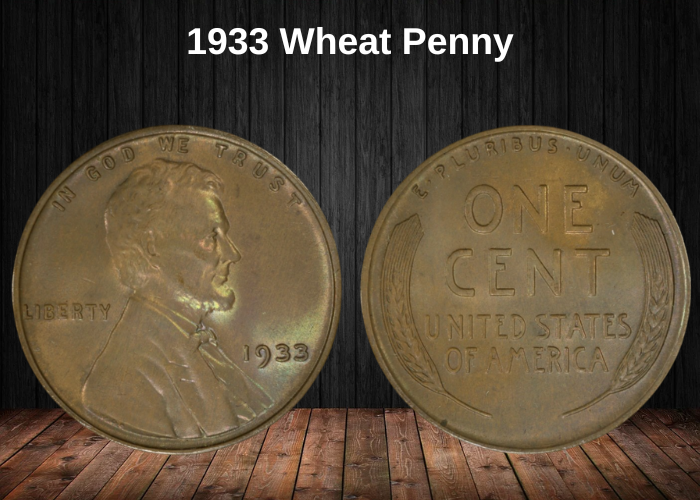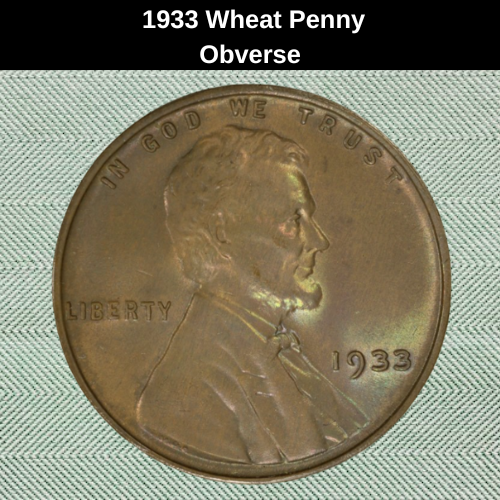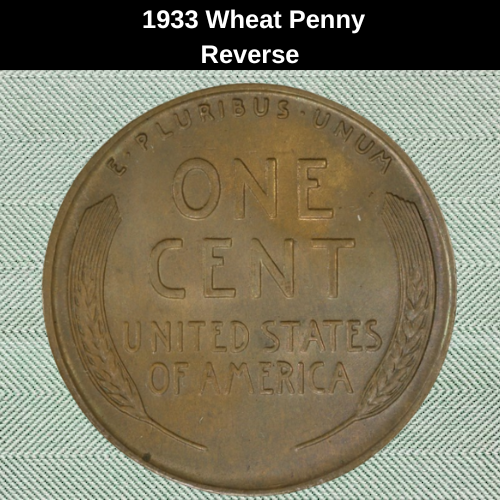The 1933 Wheat Penny is a valuable and historically important coin from the Lincoln cent series. Minted during the heart of the Great Depression, it is sought after not only for its age and design but also for its low mintage and potential errors. Whether you’re a beginner collector or a seasoned numismatist, the 1933 penny deserves a spot in your collection.
1933 Wheat Penny Value Chart (Brown Coins)
Here’s an overview of the value of 1933 Wheat Pennies in circulated (brown) condition:
| Mint Mark | Good (G-4) | Fine (F-12) | Very Fine (VF-20) | Extremely Fine (EF-40) | Uncirculated (MS-60+) |
|---|---|---|---|---|---|
| No Mint Mark (Philadelphia) | $1.50 – $3.00 | $3.00 – $6.00 | $6.00 – $10.00 | $12.00 – $20.00 | $35.00 – $85.00+ |
| D (Denver) | $3.00 – $6.00 | $6.00 – $10.00 | $10.00 – $18.00 | $18.00 – $40.00 | $50.00 – $120.00+ |
| S (San Francisco) | $4.00 – $8.00 | $8.00 – $14.00 | $15.00 – $25.00 | $25.00 – $45.00 | $70.00 – $150.00+ |
💡 Higher-grade coins or those with rare errors can be worth hundreds of dollars.
History of the 1933 Wheat Penny

The 1933 Wheat Penny was struck at a time when the United States was still in the grips of the Great Depression. As a result, fewer coins were needed for circulation, and mintages were relatively low. This has contributed to their modern rarity and collectibility.
Unlike some earlier years, 1933 pennies were only struck in Philadelphia and Denver. There is no official record of 1933-S Wheat Pennies, making any coin with an “S” mint mark highly questionable or potentially counterfeit.
1933 Wheat Penny Types
The recognized types of 1933 Wheat Pennies are:
- 1933 (No Mint Mark) – Minted in Philadelphia
- 1933-D – Minted in Denver
⚠️ A 1933-S Wheat Penny is not officially recognized, and any such coin should be authenticated professionally.
Features of the 1933 Wheat Penny
The 1933 Lincoln cent carries the classic Wheat Penny design:
- Obverse: Abraham Lincoln facing right
- Reverse: “ONE CENT” surrounded by two wheat stalks
- Edge: Plain
- Metal Composition: 95% Copper, 5% Tin and Zinc
The Obverse of the 1933 Wheat Penny

On the front (obverse):
- Portrait of Abraham Lincoln
- The motto “IN GOD WE TRUST” above
- “LIBERTY” to Lincoln’s left
- The date “1933” to his right
- A mint mark (if present) under the date
The Reverse of the 1933 Wheat Penny

On the reverse side:
- Large “ONE CENT” denomination
- “UNITED STATES OF AMERICA” beneath
- “E PLURIBUS UNUM” at the top
- Two stylized wheat stalks framing the sides
1933 Wheat Penny Details
- Designer: Victor D. Brenner
- Weight: 3.11 grams
- Diameter: 19 mm
- Composition: 95% copper, 5% tin and zinc
- Edge: Plain
- Mints: Philadelphia (No Mint Mark), Denver (D)
Other Features of the 1933 Wheat Penny
The 1933 penny is known for its:
- Historic context (Depression-era)
- Lower mintage
- Absence of a San Francisco version
- Potential for valuable mint errors
- Strong interest among Lincoln cent collectors
1933 Wheat Penny Grading Guides
Coin grading directly affects a coin’s value:
- G-4 (Good): Worn flat, major features visible
- F-12 (Fine): Moderate wear, legends readable
- VF-20 (Very Fine): All details clear, light wear
- EF-40 (Extremely Fine): Minimal wear, strong features
- MS-60+ (Mint State): Uncirculated, full detail, may show some marks or luster loss
🔍 Coins graded MS-65 or higher are extremely valuable.
1933 Wheat Penny Value Guides
Here’s a general value breakdown by grade:
- G-4 to F-12: $1.50 to $6.00
- VF to EF: $10.00 to $40.00
- MS-60+: $35.00 to $150.00+
- MS-65+ with full red color or errors: $300 to $1,000+
1933 No Mint Mark Wheat Penny Value
- Minted in Philadelphia
- Most common 1933 Wheat Penny
- Value Range: $1.50 to $85.00, depending on condition
1933 D Wheat Penny Value

- Minted in Denver
- Scarcer than the Philadelphia version
- Value Range: $3.00 to $120.00+
- Uncirculated examples with full red luster are highly collectible
Always get such coins authenticated by a trusted grading service (PCGS or NGC).
Rare 1933 Wheat Penny Errors List
Here are some errors that can greatly boost the coin’s value:
- Double Die Obverse (DDO) – Doubling on date or lettering
- Repunched Mint Mark (RPM) – Mint mark punched more than once
- Off-Center Strike – Part of the design is missing
- Die Cracks – Raised lines from cracks in the minting die
- BIE Error – A die break between the “B” and “E” in “LIBERTY”
- Clipped Planchet – A curved portion of the coin is missing due to miscut
Some of these errors can sell for $100 to over $500 depending on condition and severity.
The 1933 Wheat Penny is a small but mighty piece of American history. It combines the charm of the Lincoln Wheat design with the intrigue of low mintage and rare errors. Whether you’re aiming to complete a Lincoln set or simply admire coins from the Great Depression era, the 1933 penny stands out as both affordable and potentially valuable. Always be on the lookout for high-grade examples and error coins, as these can significantly increase your collection’s worth.
Where to sell your penny?
Now that you know the value of your penny, you might be wondering where to sell it. Don’t worry: here’s a guide to some of the best online platforms where you can easily sell your coins, along with their advantages and disadvantages.
Discover the best platforms for selling coins online (pros and cons).
FAQ
1. Why is the 1933 Wheat Penny notable despite being from a high-mintage year?
The 1933 Wheat Penny had a relatively high mintage (over 35 million from Philadelphia), but it’s notable because it was produced during the worst years of the Great Depression. Although not rare in quantity, it’s historically significant as one of the last coins made before minting dramatically slowed down in the mid-1930s due to limited economic activity and coin demand.
2. What impact did the Great Depression have on the preservation and condition of 1933 pennies?
Because the economy was in severe decline, most 1933 pennies were heavily circulated and used extensively in daily transactions. As a result, mint state (uncirculated) examples are far less common today. Many people didn’t have the luxury to set aside coins for collecting, so well-preserved specimens are now more desirable and valuable.
3. Why was the 1933 Wheat Penny only produced at the Philadelphia Mint?
The 1933 penny was minted solely at the Philadelphia Mint, with no Denver (D) or San Francisco (S) mintmarks that year. This was due to reduced demand for coinage as a result of the economic downturn, leading the U.S. Mint to consolidate production and cut costs. This makes 1933 one of the few years where the penny was minted in only one location.
4. What is the value of a 1933 Wheat Penny in different conditions, and what factors influence it most?
In circulated grades, the 1933 penny is typically worth $1–$5 depending on wear. However, in MS65 Red (mint state with full red luster), prices can exceed $150–$250, and even higher for coins with exceptional eye appeal. The most influential value factors include color (Red vs. Red-Brown/Brown), grade, strike quality, and originality (uncleaned surfaces).
5. Are there any known varieties or error coins from 1933 that increase collector interest?
While no major varieties or doubled dies are officially documented, some collectors have reported die cracks, lamination errors, and off-center strikes in 1933 Wheat Pennies. These minor errors can add modest premiums, especially when found on high-grade coins. It’s worth checking these coins under magnification for any unusual features.
6. How does the scarcity of high-grade 1933 Wheat Pennies affect their investment potential?
Though common in lower grades, high-grade 1933 pennies, especially in MS65 RD and above, are much harder to find and are strongly sought after by registry set collectors. Since most circulated extensively, uncirculated red coins are becoming scarcer, increasing their long-term investment appeal as demand for premium examples rises.
7. What role does the 1933 Wheat Penny play in a complete Wheat Cent collection?
The 1933 penny is essential for completing a full Wheat Cent date set. Its uniqueness as a single-mint issue adds historical and collecting value, even if it’s not extremely rare. Collectors aiming for full sets by date (1909–1958) and mint must include the 1933 issue, particularly in high-grade condition for competitive sets or grading registries.



















































